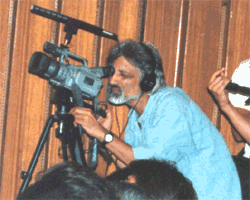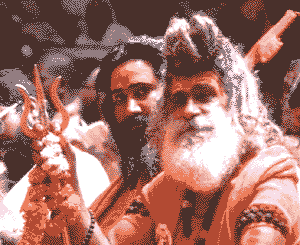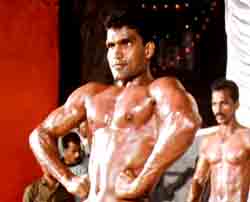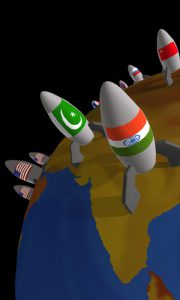An Angst in Saffron
BY SANDIP ROY-CHOWDHURY

 Patwardhan explained that he had no illusions that audiences abroad would necessarily be progressive and left-leaning. He said, “I can’t take for granted that immigrant audiences will be sympathetic to my films. Indians and Pakistanis here want to be proud of their roots. And somehow it’s hard to be proud of what I am saying.” He had that right. This year the American Museum of Natural History found itself the target of a furious campaign by angry Hindus who objected to them planning to screen his films We Are Not Your Monkeys and In the Name of God as part of an ongoing exhibition ofHinduismMeeting GodElements of Hindu Devotion. The Vishwa Hindu Parishad of America (VHPA) demanded that the museum cancel the screenings of the films because they are “anti-Hindu” and “irrelevant to an exhibit on Hinduism.”
Patwardhan explained that he had no illusions that audiences abroad would necessarily be progressive and left-leaning. He said, “I can’t take for granted that immigrant audiences will be sympathetic to my films. Indians and Pakistanis here want to be proud of their roots. And somehow it’s hard to be proud of what I am saying.” He had that right. This year the American Museum of Natural History found itself the target of a furious campaign by angry Hindus who objected to them planning to screen his films We Are Not Your Monkeys and In the Name of God as part of an ongoing exhibition ofHinduismMeeting GodElements of Hindu Devotion. The Vishwa Hindu Parishad of America (VHPA) demanded that the museum cancel the screenings of the films because they are “anti-Hindu” and “irrelevant to an exhibit on Hinduism.”
Certainly Patwardhan’s take on Hindu fundamentalism is not one the VHPA would be comfortable with. The kar sevaks in his film rant, “Muslims are our tenants. We need to repossess our house.” Shiv Sena leaders like Bal Thackeray make jibes about circumcision. The chants of maarenge ya mar jayenge, mandir waha hi banayenge (We will kill or be killed, but we will build the temple over there) might sound rousing in the heat of the moment in Ayodhya but in air-conditioned American auditoriums they sound much more frenzied and bloodthirsty. But Patwardhan did not cook them up in an editing room. He was there with his camera documenting the rise of Hindu fundamentalism in hot little towns of Uttar Pradesh.
But even he never believed the Babri Masjid would actually be demolished. “I thought the BJP (Bharatiya Janata Party) would not destroy its own symbol,” he said thinking, that a standing mosque would be a much more potent rallying point than rubble! For people like him, the destruction of the masjid was both a wake-up call and a rude awakening. “I personally underestimated the groundswell of support they were able to generate,” he admitted. “That overwhelmed the state machinery there and anyway elements in the state machinery were involved as well on the side of the kar sevaks.”
For better or for worse (depending on which side of the fence you are on) an assertive Hindu nationalism in India was on the march. That journey ended not just in Ayodhya, but in the cracked barren earth of Pokhran. The first nuclear tests were code-named the “Smiling Buddha.” On Buddha Purnima in 1998, the day that marks the enlightenment of the Buddha, the Buddha smiled again and again and again in Pokhran as India conducted three underground nuclear tests there in 1998. Nationalism, Hindu pride, manhood formed an explosive khichdi. Atal Behari Vajpayee became Atom Bomb Vajpayee overnight. The irony of the nuclear explosions on Buddha Purnima was lost in the national jubilation There was a music video about the bomb, celebrations on the street. Nuclear nationalism had India swollen with pride. Pokhran, it was said, had ignited every atom of manhood and Patwardhan was there with his camera to document a newly tumescent nation in War and Peace.
“Now no Indian has to show his passport, the whole world knows where India is,” said politician Pramod Mahajan after the nuclear tests. According to Patwardhan though it’s not the “world” that India is focused onit’s the U.S. In his film not just Mahajan, but nuclear scientist Abdul Kalam and the Shankaracharya all talk about America. “We have a love-hate obsession with America,” Patwardhan explained. India and Pakistan have been likened to two wives competing for America’s attention. Every smile from America to one ricochets off the other and unleashes a fierce competition. The nuclear tests were no exception. As Pakistan followed suit with its own testsAmerica grumbled and imposed sanctions. But at least they noticed. It was, in some ways, all about respect.
Even though television had probably not broadcast so many images of rejoicing Indians since India won the World Cup, Patwardhan doggedly claimed, “There was a small anti-nuclear movement that was not reported. Ninety percent of the people were actually ignorant about the bomb. Whenever we did screenings using films about Hiroshima in slum areas in Bombay, the discussion completely changed.”
“I CAN’T TAKE FOR GRANTED THAT IMMIGRANT AUDIENCES WILL BE SYMPATHETIC TO MY FILMS. INDIANS AND PAKISTANIS HERE WANT TO BE PROUD OF THEIR ROOTS. AND SOMEHOW IT’S HARD TO BE PROUD OF WHAT I AM SAYING.”

In fact, several survivors of the atomic blasts of Hiroshima and Nagasaki actually came to India to share their stories of five decades of pain and suffering. Patwardhan himself went to Japan to film their stories and that segment forms one of the most moving portions of War and Peace. It is anti-nuclear activism that is all the more effective because of how quiet it is. There is no Berkeley-type eco-friendly, vegan, peace-and-love chanting. Nor is it angry activists pointing accusing fingers at governments as they reel off horror stories about malformed babies covered with tumors. One of the survivors is asked “Were you angry?” The old man, sick and frail, merely answers, “I was sad.” The dignity of that response was profound. “He was taking responsibility for the American action as a human being,” reflected Patwardhan. “Saying we should not do this to other living species. It was not about blame.”
But there is plenty of blame to go around in War and Peace. As the country burst firecrackers to celebrate, Patwardhan interviewed residents of old blast sites to see how they are doing years after the first tests. The idea was that an underground explosion in the empty deserts would create a shell of molten sand. But what happens if the sand melts and the radiation gets into the water? There is Badhuram’s wife who got cancer after 1974, when the first Pokhran blasts took place. A boy named Ramesh is covered with tumors. Can Ramesh’s tumors be linked to those supposedly “safe” blasts? Politicians will deny it. Patwardhan obviously is not buying any of it.
The euphoria that followed the nuclear tests immediately meant anyone who opposed it got branded as unpatriotic. That put many peace activists on the defensive. But Patwardhan claimed it actually gave the Pakistan Indian Forum for Peace and Democracy, which he is part of, an extra boost. Now that the genie was out of the bottle the need for people-to-people dialogue between the two countries felt even more urgent. He called it the “silver lining in the mushroom cloud.”
The popular notion is that Indians and Pakistanis cannot but empathize with each otherbecause their histories spring from a common root. It’s jingoistic opportunistic governments that get in the way. But at least in India, that government, being elected by the people, supposedly represents the people. But Patwardhan is adamant that this Indian-Pakistani bhai-bhai is no romantic leftist pipe dream. “Anyone visiting India from Pakistan or vice versa are treated with tremendous warmth and hospitality. Precisely because we have been told that this is the enemy, there is a lot of curiosity about it till you realize that they are just like us. Then the whole thing breaks down.”
THE CHANTS OF MAARENGE MAR JAYENGE, MANDIR WAHIN BANAYENGEMIGHT SOUND ROUSING IN THE HEAT OF THE MOMENT IN AYODHYA, BUT IN AIR-CONDITIONED AMERICAN AUDITORIUMS THEY SOUND MUCH MORE FRENZIED AND BLOODTHIRSTY
 He tries to show it in a film as well when he films students at an elite Pakistani school and elicits their views on the bomb. “They started out with lots of jingoistic speeches about the bomb,” he recalled. “Towards the end, as they realized I wasn’t a supporter of the Indian bomb, they dropped their pose and started saying honestly that they did not agree with the bomb either.”
He tries to show it in a film as well when he films students at an elite Pakistani school and elicits their views on the bomb. “They started out with lots of jingoistic speeches about the bomb,” he recalled. “Towards the end, as they realized I wasn’t a supporter of the Indian bomb, they dropped their pose and started saying honestly that they did not agree with the bomb either.”
Patwardhan’s modus operandi is to interview those he disagrees with and let them hang themselves with their own words. But Ramanna is an urbane piano-playing intellectual no foaming-at-the-mouth radical with bloodshot eyes. Patwardhan admitted, “The danger of (people like Ramanna and Bharat Ratan Abdul Kalam) was he was so hospitable. This often happens with people you don’t agree with at all. At a human level they are very nice. And you feel guilty that eventually this will not be complimentary to them. I overcame my sense of middle-class guilt of being a namakharameating his dinner and making him look bad, because I had to keep the larger context in mind.”
It is this quest to document the larger context that drives Anand Patwardhan. It’s not always the most rewarding of journeys, however many awards might come along the way. It is surely frustrating when sometimes you feel you are fighting against the tide with your camera. But that is something he has had practice forafter all the man used to work in the trenches with Cesar Chavez’s farm workers’ union when he was in America as a student.
He tries to avoid labeling himself but sometimes calls himself a “Gandhian socialist”somewhere in the continuum between Gandhism and Marxism. As people dismiss Gandhi as completely impractical in the modern world, Patwardhan is not so sure. He wonders wistfully if Gandhi might not have been able to disarm Osama bin Laden without needing to carpet-bomb Afghanistan. For the likes of Anand Patwardhan, there has not been a lot of good news lately. If there have been spurts of hope, they have been overshadowed by war, nuclear stockpiles, and a fresh swathe of bloody communal riots. But he keeps going. He shrugged, “I don’t know any other thing to do. This is what I do best.”